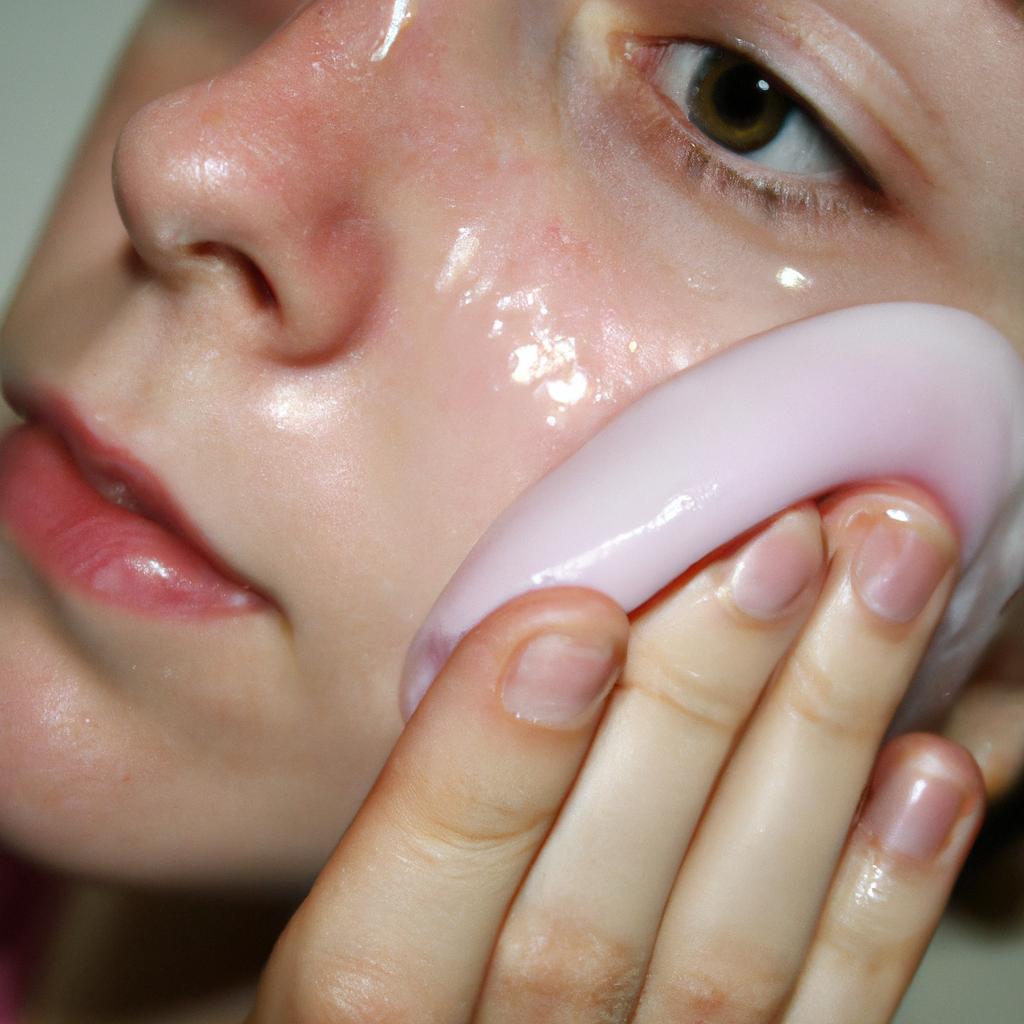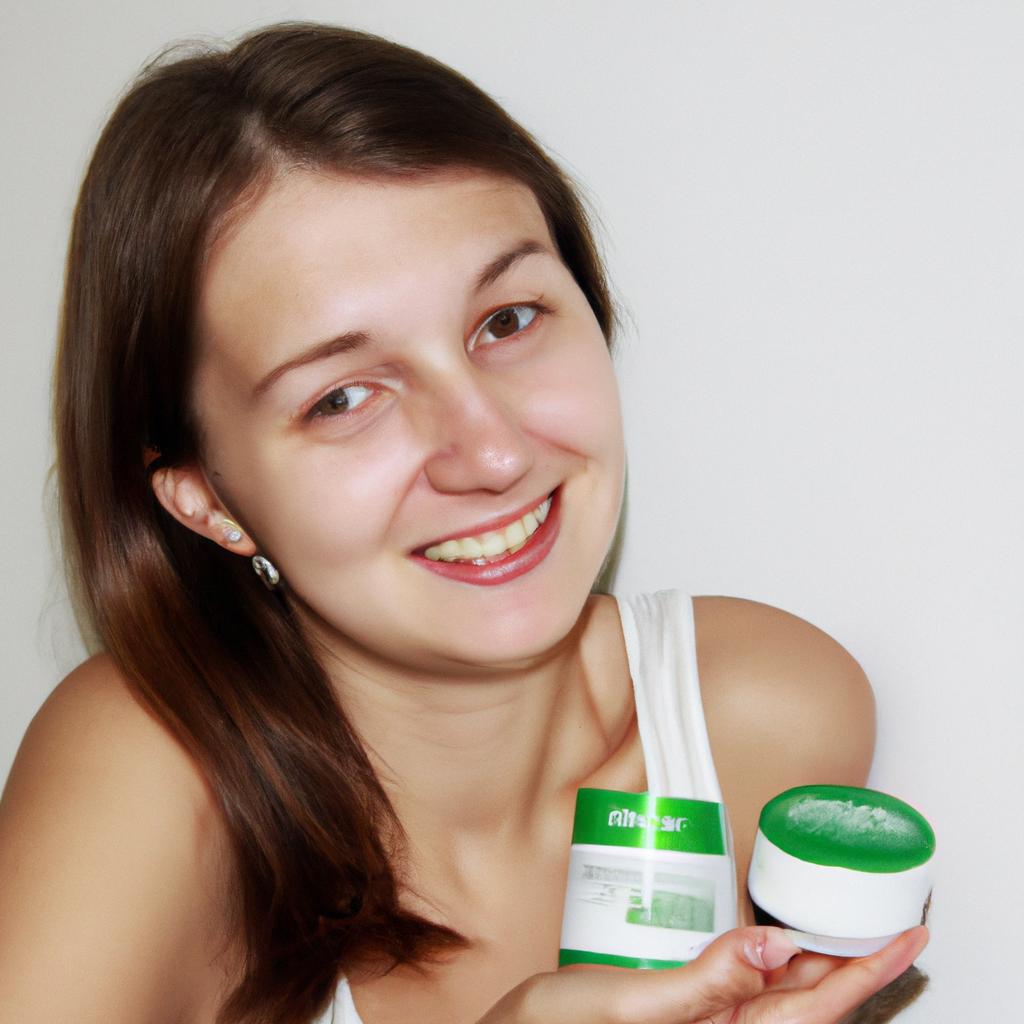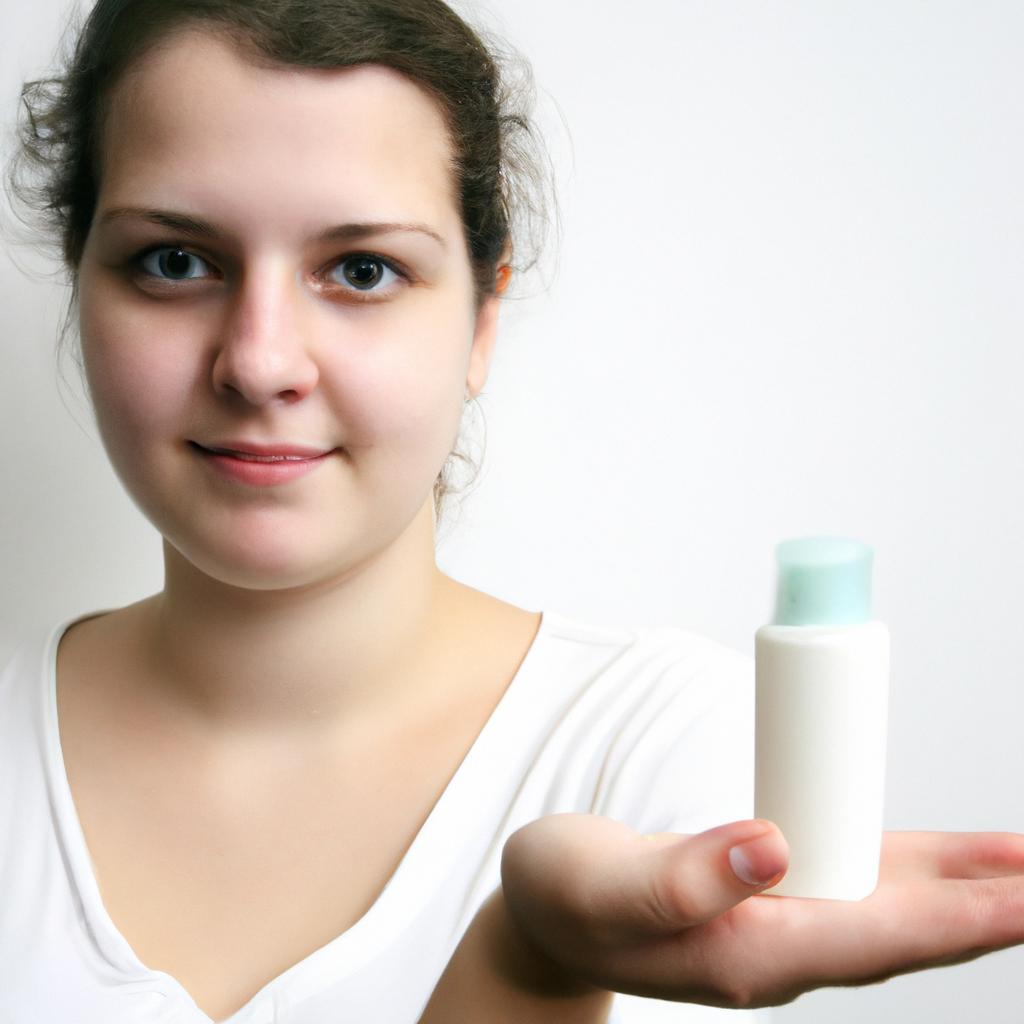Exfoliation is a widely practiced skincare technique that involves the removal of dead skin cells from the surface of the skin. This process not only enhances the overall appearance and texture of the skin but also promotes better absorption of skincare products, leading to improved effectiveness. To illustrate this point, consider a hypothetical case study: Jane, a 35-year-old woman with dry and dull-looking skin, decides to incorporate exfoliation into her skincare routine. After just a few weeks of regular exfoliation using gentle scrubs, she notices significant improvements in her complexion – her skin appears brighter, smoother, and more radiant.
The benefits of exfoliation extend beyond mere cosmetic enhancements. By removing dead skin cells that accumulate over time, exfoliation stimulates cell turnover and encourages the growth of new, healthy cells. This revitalizing process can help address common skin concerns such as clogged pores, uneven tone or texture, acne breakouts, and signs of aging like fine lines and wrinkles. Furthermore, exfoliating can promote collagen production by stimulating blood circulation to the outer layers of the skin. As a result, it aids in maintaining elasticity and firmness while reducing the appearance of sagging or tired-looking skin.
In light of these advantages, it becomes clear why In light of these advantages, it becomes clear why exfoliation is considered an essential step in a well-rounded skincare routine.
Why Exfoliation is Important for Skin Health
Why Exfoliation is Important for Skin Health
Introduction
Imagine a scenario where someone has been struggling with dull and rough skin, plagued by clogged pores and stubborn acne. Despite trying various skincare products, their efforts seem futile. However, upon incorporating exfoliation into their routine, they notice a remarkable transformation in the texture and appearance of their skin. This example highlights the significance of exfoliation as a crucial step in achieving optimal skin health.
Enhanced Skin Renewal
Exfoliation plays a fundamental role in promoting healthier skin by removing dead skin cells that accumulate on the surface over time. These dead cells can lead to clogged pores, uneven tone and texture, and an overall lackluster complexion. By eliminating this barrier through regular exfoliation, new skin cells are able to emerge, resulting in a fresh and radiant appearance.
Improved Product Absorption
Another key benefit of exfoliation is its ability to enhance the absorption of skincare products. When dead skin cells are eliminated from the surface layer, active ingredients found within serums, moisturizers, and other treatments can penetrate deeper into the epidermis. As a result, these products become more effective at addressing specific concerns such as fine lines, hyperpigmentation or dryness.
Boosted Collagen Production
Collagen production is essential for maintaining youthful-looking skin; however it naturally declines with age. Regular exfoliation stimulates collagen synthesis by activating cell turnover mechanisms. This increased collagen production not only helps to improve elasticity but also contributes to reducing the appearance of wrinkles and sagging over time.
Elevated Confidence and Well-being
Embracing exfoliation as part of one’s skincare routine offers emotional benefits beyond physical improvements alone. The act of caring for oneself can be therapeutic and empowering. It fosters self-confidence as individuals witness positive changes in their complexion while simultaneously engaging in self-care rituals that promote personal well-being.
- Say goodbye to dull and rough skin
- Achieve a more radiant complexion
- Enhance the absorption of skincare products
- Reduce the appearance of wrinkles and sagging
Markdown Table:
| Benefit | Description |
|---|---|
| Enhanced Skin Renewal | Removal of dead cells for improved texture |
| Improved Product Absorption | Deeper penetration of active ingredients |
| Boosted Collagen Production | Stimulate collagen synthesis for increased elasticity |
| Elevated Confidence | Emotional well-being and self-confidence through self-care |
Transition into the subsequent section about “Different Types of Exfoliants and How They Work”:
Understanding why exfoliation is crucial for maintaining optimal skin health, it is now important to explore the different types of exfoliants available in order to make informed choices. By understanding how these exfoliants work, individuals can select the most suitable option based on their unique needs and preferences.
Different Types of Exfoliants and How They Work
Imagine a scenario where Jane, a 35-year-old woman with dry and dull skin, starts incorporating regular exfoliation into her skincare routine. She diligently follows the recommended steps and uses suitable exfoliants for her skin type. Over time, she notices remarkable improvements in her complexion – her skin appears brighter, smoother, and more youthful. This case study exemplifies how maximizing the benefits of exfoliating can yield impressive results.
To ensure you get the most out of your exfoliation routine, it is essential to follow some best practices. Here are key considerations:
-
Frequency: The frequency of exfoliation depends on individual factors such as skin type and sensitivity. While some people may benefit from daily exfoliation, others should limit it to once or twice a week. Experimentation is crucial to find what works best for you.
-
Gentle Techniques: Regardless of the chosen exfoliant, adopting gentle techniques during application is vital to avoid irritation or damage to the skin barrier. Use light pressure and circular motions when massaging the product onto your face or body.
-
Moisturize: After exfoliating, replenishing moisture becomes even more critical as this process can temporarily strip away natural oils from the skin’s surface. Apply a hydrating moisturizer immediately after exfoliating to nourish and protect your newly revealed skin cells.
-
Sun Protection: Exfoliated skin tends to be more sensitive to sun exposure due to its increased vulnerability. Shielding your freshly exfoliated skin with broad-spectrum sunscreen will help prevent sunburns and minimize potential long-term damage caused by harmful UV rays.
By adhering to these guidelines, you can optimize the benefits of exfoliating while minimizing any possible side effects.
Now that we have explored ways to maximize the benefits of exfoliation let us delve into understanding different skin types further in our next section: “Best Practices for Exfoliating Different Skin Types.” This will help you tailor your exfoliation routine to address the specific needs of your skin.
Best Practices for Exfoliating Different Skin Types
Maximizing the benefits of exfoliating is crucial for achieving optimal skin care results. In this section, we will explore best practices that cater to different skin types, ensuring a personalized approach for every individual.
Imagine Sarah, who has dry and sensitive skin. She wants to incorporate exfoliation into her skincare routine but is concerned about potential irritation. By following these guidelines, she can safely enhance her skin without compromising its health:
- Gentle Exfoliants: Opt for mild exfoliants such as chemical peels with lower concentrations or physical scrubs with fine particles. These options are less abrasive on the skin, minimizing the risk of irritation.
- Frequency: Individuals with dry and sensitive skin should limit exfoliation to once or twice a week to prevent over-exfoliation and maintain the natural moisture barrier.
- Moisturize: After exfoliating, it’s essential to replenish moisture by applying a hydrating moisturizer suitable for specific skin needs. This step helps restore any lost hydration during the exfoliation process.
- Patch Test: Always perform a patch test before trying new products or techniques to ensure compatibility with your unique skin type.
| Skin Type | Suitable Exfoliant | Recommended Frequency | Key Benefits |
|---|---|---|---|
| Dry | Chemical Peels | Once or Twice a Week | Promotes cell turnover and boosts radiance |
| Oily | Salicylic Acid | Two or Three Times | Unclogs pores and controls excess oil production |
| Combination | Enzyme Scrubs | Twice a Week | Gently removes dead cells while balancing sebum |
| Sensitive | AHA/BHA | Once Every 10 Days | Mild exfoliation without causing irritation |
By adhering to these best practices and selecting appropriate exfoliants based on individual skin types, individuals can effectively maximize the benefits of exfoliating while minimizing potential adverse effects. This personalized approach ensures that each person’s unique needs are met.
Transitioning into the subsequent section about “The Benefits of Regular Exfoliation,” let us now explore how consistent exfoliation can contribute to overall skin health and appearance.
The Benefits of Regular Exfoliation
Maximizing the Benefits of Exfoliation
Imagine a scenario where two individuals with different skin types, Person A and Person B, decide to incorporate exfoliation into their skincare routines. Both diligently follow the best practices for their respective skin types. After several weeks, they observe notable improvements in their skin’s texture and appearance. This example highlights the importance of maximizing the benefits of exfoliation through proper techniques and regularity.
To achieve optimal results from exfoliating, it is crucial to consider various factors that can impact its effectiveness. Here are some key considerations:
-
Choosing the Right Exfoliant: Different exfoliants work better for specific skin types or concerns. For sensitive or dry skin, chemical exfoliants like alpha hydroxy acids (AHAs) or beta hydroxy acids (BHAs) may be gentler options compared to physical scrubs containing harsh particles. On the other hand, oily or acne-prone skin might benefit from salicylic acid-based products that penetrate deeply into pores.
-
Frequency of Exfoliation: While it is essential to remove dead skin cells regularly, over-exfoliating can lead to irritation and damage the skin’s protective barrier. Finding the right balance is critical – generally, once or twice a week works well for most individuals. However, those with more resilient skin may tolerate higher frequencies.
-
Customization based on Skin Condition: Adjusting your exfoliation routine according to changes in your skin condition can maximize its benefits further. For instance, during colder months when the skin tends to be drier, using a milder exfoliant combined with ample moisturization can prevent excessive drying.
-
Post-Exfoliation Care: Following up an exfoliation session with appropriate skincare steps helps maintain healthy and nourished skin. Applying a hydrating serum or moisturizer after removing dead cells ensures adequate hydration and replenishment.
Consider the following table, which showcases the potential benefits of regular exfoliation:
| Benefit | Description |
|---|---|
| Smoother Texture | Regularly removing dead skin cells promotes a smoother and more even skin texture. |
| Brighter Complexion | Exfoliating helps to reveal fresh, new skin cells, resulting in a brighter complexion. |
| Unclogged Pores | By clearing away debris and excess oils, exfoliation can help prevent pore congestion. |
| Enhanced Product Absorption | Removing the barrier of dead skin allows skincare products to penetrate more effectively. |
By implementing these practices and understanding how they contribute to maximizing the benefits of exfoliation, individuals can achieve healthier-looking skin over time.
Transitioning into the subsequent section about “Precautions to Take When Exfoliating,” it is crucial to be aware of certain measures that should be followed for safe and effective exfoliation.
Precautions to Take When Exfoliating
Transition from the previous section:
Having explored the numerous benefits of regular exfoliation, it is crucial to be mindful of certain precautions while incorporating this skincare practice into our routines. By understanding these precautions and taking appropriate measures, we can ensure that exfoliating maximizes its benefits without causing any harm or adverse effects.
Precautions to Take When Exfoliating
To illustrate the importance of following proper precautions, let us consider a hypothetical case study. Emily, a 30-year-old woman with sensitive skin, decided to incorporate exfoliation into her skincare routine after hearing about its remarkable benefits. Initially excited about achieving smoother and healthier-looking skin, she began exfoliating daily using a scrub containing coarse granules. However, over time, Emily noticed increased redness and irritation on her face, which led her to seek professional advice.
To prevent such experiences and optimize the effectiveness of your exfoliation routine, keep in mind the following precautions:
- Choose the right type of exfoliant: Different individuals have varying skin types and conditions; therefore, selecting an exfoliant that suits your specific needs is essential. Whether you opt for physical scrubs or chemical exfoliants like AHAs or BHAs, ensure they are suitable for your skin type and concerns.
- Avoid excessive force: Applying too much pressure during physical exfoliation can damage the delicate surface layer of your skin. Gentle circular motions with light pressure are recommended to avoid potential irritation.
- Be consistent but not excessive: While regularity is key when it comes to reaping the full rewards of exfoliation, it’s vital not to overdo it. Excessive exfoliation can disrupt the natural balance of your skin barrier and lead to dryness or sensitivity issues.
- Protect your skin afterward: After each session of exfoliation, take extra care by applying moisturizers or serums enriched with hydrating ingredients. This helps to replenish the moisture lost during exfoliation and maintain a healthy skin barrier.
To further highlight the significance of these precautions, let us consider the following table:
| Precaution | Importance |
|---|---|
| Choose suitable exfoliant for your skin type | Prevents irritation and damage |
| Apply gentle pressure during physical exfoliation | Avoids harming the skin’s surface layer |
| Maintain a consistent but moderate exfoliation routine | Preserves the natural balance of the skin |
| Follow up with moisturizers or serums after exfoliating | Replenishes lost moisture and supports skin health |
By adhering to these precautions, you can enhance the benefits of regular exfoliation while safeguarding your skin against potential harm.
Incorporating conscious skincare practices into our routines is essential, which leads us to explore how we can seamlessly integrate exfoliation into our daily regimen. The next section will guide you on how to effectively incorporate this beneficial step without disrupting your skincare routine.
How to Incorporate Exfoliation into Your Skincare Routine
Precautions to Take When Exfoliating:
In the previous section, we discussed the importance of exfoliation in skincare and its numerous benefits. Now, let’s delve into some key precautions that should be taken when incorporating exfoliation into your skincare routine.
Case Study: Sarah is a 30-year-old woman with sensitive skin who recently started exfoliating as part of her skincare regimen. She noticed that after exfoliating, her skin became red and irritated, which led her to wonder if she was doing something wrong. This case study highlights the significance of understanding and following proper precautions while exfoliating.
To maximize the benefits of exfoliation while minimizing any potential negative effects, consider the following precautions:
- Patch Test: Before applying any new exfoliating product or technique to your entire face or body, perform a patch test on a small area of skin first. This will help determine if you have any adverse reactions or sensitivities to the product.
- Frequency: Over-exfoliation can lead to irritation and damage to the skin barrier. It is essential to find an appropriate frequency for your specific skin type and condition. Generally, once or twice a week is sufficient for most individuals.
- Gentle Techniques: Avoid using harsh scrubs or aggressive techniques that can cause micro-tears in the skin. Instead, opt for gentle chemical exfoliants such as alpha-hydroxy acids (AHAs) or beta-hydroxy acids (BHAs), which work by dissolving dead skin cells without physical abrasion.
- Sun Protection: Exfoliation can make your skin more susceptible to sun damage since it removes the top layer of dead cells that act as a natural protective barrier against UV rays. Always follow up with adequate sunscreen application after exfoliating.
These precautions are crucial in ensuring safe and effective results from your exfoliation routine. By taking these measures carefully, you can enhance your skin’s texture, promote cell turnover, and achieve a healthy, radiant complexion.
| Precautions to Take When Exfoliating |
|---|
| 1. Patch Test |
| 2. Frequency |
| 3. Gentle Techniques |
| 4. Sun Protection |
By following these precautions, you can ensure that exfoliation remains a beneficial addition to your skincare routine while avoiding any potential drawbacks associated with improper usage.
Remember, everyone’s skin is unique, so it is essential to observe how your own skin responds to different products and techniques. By being mindful of these precautions and adapting them accordingly, you can enjoy all the benefits of exfoliation without compromising the health and integrity of your skin
 Stanley Beauty Care
Stanley Beauty Care



